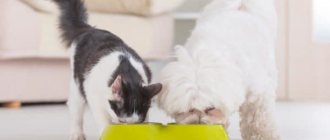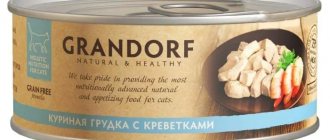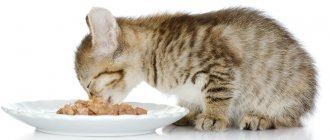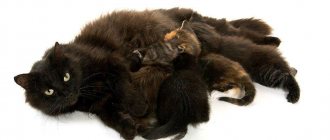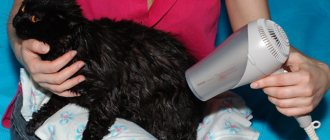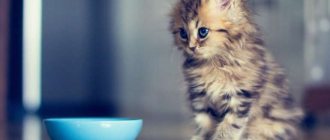What is the difference between dry food for kittens and ready-made diets for adult cats?
Most often, a fundamental difference in composition is found only in the case of not very high-quality feed: economy and premium. Because kittens require more nutrients, producers are forced to either change the proportions of nutrients through supplements or use more meat and by-products instead of plant extracts. The latter method is more typical of bona fide corporations: kittens absorb substances better if they are presented with whole ingredients. In the case of holistic products, the difference can sometimes be only in the size of the granules, since manufacturers do not save on raw materials.
Size and structure of granules
Most often, manufacturers produce more porous granules for babies, so that it is easier for them to chew the pieces with their baby teeth. At the same time, this helps cleanse the fangs of plaque and prevents the formation of stone deposits. The kibble in kitten foods is usually smaller because the larger pieces are difficult for babies to handle.
Food granules for kittens can have an unusual shape: a heterogeneous structure is more attractive to animals, which improves appetite and makes it easier to get accustomed to ready-made diets
Cat teeth are not designed for thoroughly grinding food: due to the anatomical features, the predator's mouth is more suitable for tearing meat from a large carcass. In addition, it should be taken into account that kittens' enamel is about 10 times thinner than human enamel. For these reasons, too large granules can cause problems with teeth and their further destruction.
Tartar appears as yellowish or dark accumulations of plaque near the roots of the fangs.
The reverse exchange is also dangerous: adult cats can choke on small granules. I now have a grown kitten (6 months old) and an adult cat living at home. I have to give them one food because the old-timer is used to free access and steals from someone else's bowl. I chose Grandorf holistic for kittens, but the granules in it are too small for my cat. He doesn't chew them, he swallows them whole. After a month of such feeding, the pet developed an unpleasant odor from the mouth; upon examination, I discovered a plaque. Since I was quite satisfied with the composition of the food, I began brushing the cat’s teeth.
Energy value
In most cases, the energy value of kitten food is approximately 20–30 kcal per 100 g higher. This is due to the increased physical activity of babies and the rapid growth phase of internal organs. If an adult cat sleeps mainly to save energy, then kittens fall asleep solely because of fatigue. Theoretically, a pet can get more calories if it eats more granules, but this is not welcome: the load on the gastrointestinal tract increases, which, in the presence of predisposition and risk factors, can cause the development of pathologies.
From personal experience I can say that the difference in terms of calorie content does not play a big role for a kitten, but for an adult animal it is dangerous. When I gave my pets different foods, the old-timer always went to the newcomer's bowl first. Apparently, diets for kittens are more attractive due to the increased content of proteins and fats. In a month, an adult cat gained 200 g in weight. By cat standards, this is a lot, especially considering that he already has a dense physique. But in kittens fed with “adult” diets, exhaustion does not occur: my sister gave her kitten 1st Choice and Orijen, he was playful and active, the ribs could be felt with little difficulty.
Protein and fat content
Small kittens require more amino acids, since they take part in the process of division and creation of new cells, and are also needed for the correct functioning of the central nervous system, cardiovascular system and other organs. Manufacturers are trying to add more meat to baby food - the most accessible source of proteins. When feeding healthy adult cats together, an increase in protein concentration is not dangerous, but if there are even slight deviations, this will provoke pathological changes in tissues.
A deficiency of amino acids and lipids can provoke increased shedding and peeling of the skin.
Kittens require fats not only as a source of energy, but also as a building material for internal organs and tissues. Lipids help support the functioning of many internal systems: gastrointestinal tract, central nervous system, brain, heart, etc. The proportion of fats in food for kittens reaches 20%; for adult cats, the standard is 10–15%. A reduced concentration of lipids most often does not cause any abnormalities in children, but with severe deficiency, animals experience weakness and lethargy. There is a small chance of disruption of the cardiovascular system. Against the background of a lack of lipids, a deficiency of fat-soluble vitamins may occur due to deterioration of metabolism.
Low nutritional value of food can cause overeating and further development of obesity
In the budget food market, there is a tendency to create an attractive balance of proteins, fats and carbohydrates at the expense of not the most nutritious ingredients: hydrolysates of plant proteins, peas, cereals, etc. Conventionally, these ingredients do contain a certain amount of amino acids and lipids, but the data compounds are not absorbed by the short gastrointestinal tract of predators. The only available source of protein for cats is animal products. For this reason, it is important to focus not only on the balance indicated on the package, but also on the composition, otherwise the animal will regularly lack nutrients. The presence of meat ingredients in the first place and the presence of fish oil, a source of unsaturated fatty acids, are welcomed. It is advisable to avoid grain feeds and diets containing anonymous animal fats.
Concentration of vitamins and minerals
As kittens rapidly develop their musculoskeletal system and change teeth during childhood, they require more calcium and phosphorus. An increased concentration of zinc stabilizes tissue growth, prevents the appearance of defective cells, strengthens the immune system and normalizes hormonal levels, which is especially important for adolescents. Iron controls the development of internal organs and ensures the transport of oxygen. Magnesium contributes to the normal functioning of the cardiovascular system, the load on which is higher at a younger age.
The absence of a separate specialized recipe in the lines of elite brands should not confuse buyers: in the wild, kittens and adult animals eat the same products
Theoretically, the difference in the proportions of nutrients is small, so healthy kittens will not experience deviations from eating unsuitable food. Problems will appear if the animal has even minor impairments. For example, metabolism has deteriorated, which is why the kitten absorbs fewer nutrients. The presence of abnormalities in the functioning of internal organs is not always obvious, so it is better not to take risks and give the baby suitable food. It is advisable to prefer ready-made diets in which vitamins and minerals are not presented in pure form, but as whole ingredients.
When fed together, kitten food can be dangerous for adult animals. Health problems especially often arise in neutered pets. Oversaturation of feed leads to the formation of stones in the urinary system.
Dangerous consequences of feeding
Having chosen food for a kitten once, it is not recommended to switch to other brands later. Each manufacturer optimally calculates and carefully selects the correct balanced composition according to age.
Imbalances in the balance of nutrients can lead to serious health problems for your pet, such as:
- diabetes mellitus, if the animal is predisposed to juvenile diabetes mellitus (genetic inheritance);
- rickets and osteoporosis resulting from calcium metabolism (lack of calcium);
- liver diseases;
- gastritis;
- stomach ulcers;
- poisoning;
- development of diseases of the gastrointestinal tract;
- allergies in the form of rashes or hair loss.
In addition, vitamin deficiency may occur, characterized by a lack of:
- vitamin C, which has a bad effect on the immune system, and in severe cases, scurvy develops;
- vitamin E, tocopherol, which protect against active radicals that damage the cell membrane, causing dullness of the coat, irreversible changes in muscles;
- vitamin A, which weakens the immune system, leading to poor vision;
- vitamin D, responsible for calcium-phosphorus metabolism.
And this is not a complete list of problems that a kitten may encounter if it begins to consume foods that are harmful to it.
Is it possible to give a kitten food for adult cats?
The answer to the question of whether it is possible to give kittens food for adult cats primarily depends on the quality of the finished diet. A holistic product will be more beneficial than a budget specialized product, since the former contains more substances available to the kitten. It is better to abandon Whiskas, Friskas, Kitiket and similar foods in favor of the brands Acana, Orijen, Pronature Holistic, etc. It is also advisable to avoid premium products (Royal Canin, Hills ", "Proplan"), because they contain low-quality raw materials and too many grains. Even the specialized foods in the line are significantly inferior to conventional super-premium products.
In general, a kitten can do well when fed “adult” ready-made diets, but to prevent nutritional deficiencies, it is recommended to use such products only as a temporary alternative. If a baby steals some food from an older cat's bowl, there will be no dangerous consequences as long as specialized food remains the basis of the menu.
The situation is different if we are talking about non-complete feeds, i.e. treats. Most often they are made from offal: stomachs, lungs, veins, kidneys and other internal organs. The kitten's delicate gastrointestinal tract may not be able to cope with the load, which at best will lead to indigestion, at worst - severe diarrhea and dehydration, inflammation of the mucous membranes of the stomach or intestines, or blockage. Treats for adult cats can only be given to animals after one year.
Dry or wet food?
There are two types of wet food:
- pouches (“bags”) - contain quite a lot of moisture in the form of broth or sauce with pieces of food;
- canned food - packaged in metal jars of various sizes, designed for longer storage than pouches.
Dry cereals are a perfectly balanced diet for adults and children and contain a small amount of water (5-12%). They are economical, can be stored for a long time, and preserve their taste. Cats can feel great all their lives eating only dry rounds. It is always written on the packaging for owners at what age kittens can eat dry food.
The only condition! A cat eating “crackers” should always have access to a bowl filled with clean drinking water for washing down. Whether it is possible to feed a kitten with adult food is up to the owner to decide, but it is better not to do this for at least 6 months.
Kittens can be given dry food from 2-3 months. But kids should not buy economy-class products. It is better to start with premium products, the composition of which is best balanced for the correct diet of kittens.
How and when to switch a kitten to adult cat food
There is no general conventional boundary for translation. Most experts believe that a cat is considered an adult after reaching one year. Some felinologists argue that it is possible to switch your pet to a new diet only after the final formation of internal organs. The period of active growth differs depending on the sex of the animal and individual characteristics. On average, a cat’s body is fully formed by 11–12 months; cats take longer—13–14 months.
Many manufacturers specify the age limits and note that after a year it is recommended to switch the animal to another food
It is advisable to carry out the transfer slowly and not change the brand of food. Within the same line, the chemical composition of products is stable; the company uses the same raw materials for their production. If you suddenly switch to a new food, digestive disorders may occur. This is especially dangerous for animals with hypersensitivity or gastrointestinal pathologies. In emergency cases, a quick transition to food for adult cats is allowed if it is carried out within the same line, but it is better to prefer gradual habituation.
Granules of “adult” food are offered to kittens from 8–10 months as a treat in order to test the body’s reaction and begin to gradually adapt the internal organs to the new composition. At 12–14 months, the animal is mixed with a ready-made diet into its usual food, gradually increasing the proportion of the first. Ideally, the transfer should take 10–14 days. The amount of new food can be increased by about 10% every day or the diet can be changed in spurts: replace about 1/5 of the food and observe the reaction for several days, then repeat until the previous product is completely excluded from the menu. The choice of method is made individually.
Kitten food is only suitable for healthy animals; if there are pathologies, you should consult a veterinarian
Because kitten food is often more attractive, the cat may refuse food or choose only tasty kibble. In such cases, it is recommended to be persistent and continue with the transfer unless there are any specific symptoms that may indicate illness. Sooner or later the animal will give up and begin to eat according to the previous schedule. It is not recommended to offer your pet treats, coax it, or hand feed it. This will lead to pickiness and loss of appetite.
A quick or too early transfer is possible after castration or in the event of illness if the food was prescribed by a veterinarian. After surgery, the diet is changed to avoid obesity and the development of urolithiasis. In case of liver and kidney diseases, “baby” food can cause an exacerbation.
How many times a day should you feed your kitten?
From the age of one month, a kitten should begin to be taught to feed itself. He is transferred to dry and wet ready-made food within a month. It is better to give food to the baby often, but little by little. As the famous advertisement says: a kitten's stomach is smaller than a thimble. When eating dry food, the baby does not know when to stop. If he gets too full, there is a high chance of vomiting.
- When the baby is 1.5-2 months old, he needs to be given food at least 6 times a day, trying to do it at the same time.
- At the age of 4 months, you can already decide how many times a day to feed the kitten - 3 or 4. At the same time, you can leave dry granules constantly in the bowl if the owner is busy throughout the day.
- From 10 months the kitten is considered an adult.
- By the age of one year, the transition to adult nutrition is completely completed.
Veterinarians' opinion
In case of theft from a small amount of “adult” food there will be no harm.
Yulia Polesskaya
https://www.zoovet.ru/forum/?tid=35&tem=1026213
Food for adult cats is not suitable for kittens, because... They need more protein for growth and development than an adult animal.
Yulia Polesskaya
https://www.zoovet.ru/forum/?tem=891112&tid=35
It is better to feed a kitten up to 8 months with kitten food, since food for adult animals does not contain the necessary amount of nutrients required by a growing body.
Solovyova Milana
https://www.zoovet.ru/forum/?tid=35&tem=766004
Natural food or prepared food?
If there is no meat in your pet’s diet, then he begins to have problems with cell regeneration, blood clotting, and other diseases. Sugar, starch, and smoked foods are contraindicated for cats.
However, you cannot feed cats only meat, as they develop a lack of calcium in their bodies with an excess of phosphorus. Thyroid disease begins, reducing skeletal mineralization. The gait is disturbed, the hind legs fail, and loving owners run to the veterinarian because they believe that the pet jumped off from above and injured itself. In addition to meat, a cat also needs offal and plant foods.
In nature, cats obtain plant food by eating the contents of the stomachs of captured small animals. Such plants are already in a semi-digested state, ideally accepted by the digestive system of carnivores.
Porridge, fish, dairy products, and sausages are not suitable food for cats, as they provoke a concentration of urine in the body, and this, in turn, causes urolithiasis. Mineral salts from undigested foods appear as crystalline urine sediments.
So, if you feed your beloved pets the right homemade food, then creating a diet turns out to be quite a difficult task. Veterinarians are constantly asked whether it is possible to feed a kitten adult food. The best food in nature would be the little mice that the mother provided for kittens, but since there are no such mice in city apartments, the person himself must provide his pets with everything necessary for growth and proper development.
Fortunately, manufacturers have taken care of the proper nutrition of animals, producing dry and wet food for them and their babies, which contain well-balanced nutrients necessary for health.
Features of the diet for kittens
Veterinarians and felinologists recommend choosing expensive premium or super-premium products from well-known manufacturers.
These foods contain all the necessary ingredients for the trouble-free growth and full development of a kitten.
Some super-premium category foods have a comprehensive line of baby foods, taking into account the age, breed and physiological state of the kitten. Thus, Royal Canin offers:
- Royal Canin Mother and Babycat for kittens from 1 to 4 months. This food is excellent for babies in the 1st growth phase, has a delicate texture, absorbs moisture well and can be successfully used as a wet diet for the first feeding. Small soft granules are easily chewed by baby teeth, and the extremely rich chemical composition satisfies all the kitten's immediate needs.
- Royal Canin Kitten for kittens up to 12 months. This product is recommended for “teenagers” in the 2nd growth phase. The total caloric intake of the diet is reduced due to a decrease in fat (18%), but the percentage of protein compounds is increased due to active muscle growth (34%).
- Royal Canin British Shorthair Kitten is an excellent choice when raising British Shorthair kittens. The food is characterized by a high protein content (38%) for building powerful muscles, L-carnitine, taurine and omega-3 fatty acids for heart health, as well as chondroitin and glucosamine as chondroprotectors.
- Royal Canin Persian Kitten 32 for Persian kittens from 2 to 12 months - focuses on complete digestion of food, healthy skin and coat, and strengthening the immune system. The special formula of granules guarantees comfort while eating.
- Royal Canin Sterilized for sterilized kittens aged 6 to 12 months. Specially developed granules with a reduced fat content (12%) help reduce the risk of excess body weight gain after sterilization, and the balance of protein and minerals contributes to the harmonious completion of growth processes without undue stress on the excretory system.
Other recommended brands. In addition to the above products, a good choice for kittens would be:
- Orijen Cat & Kitten;
- Acana (kitten range);
- Pronature Original Kitten;
- Bosch Sanabelle Kitten.
Ban on economy category. Economy class food is attractive due to its low price, but is made from low-quality raw materials, contains a limited list of ingredients, and, in addition, is saturated with cheap dyes, flavors and preservatives, and therefore is strictly prohibited for feeding growing offspring.
Water requirements and wet rations
The constancy of a certain amount of water in the body is one of the main conditions for normal life.
According to research, it was possible to find out that:
- Water in the body of cats is a solvent and carrier of nutrients, providing cellular turgor, structure and biological properties of proteins, nucleic acids and lipids.
- The body of an adult cat weighing 4 kg contains about 2.4 liters of water, of which 60% is intracellular fluid.
- Under normal conditions, the water requirement of adult cats is about 30 ml per 1 kg of body weight, while in small kittens this figure reaches 77 ml per 1 kg of body weight.
- The amount of drinking water consumed depends on the nature of feeding, since a wet diet contains about 69-72% water, and a dry pelleted diet contains only 7-11%. When feeding “drying”, the need for liquid increases significantly.
- Obeying instinct, many cats prefer food saturated with water, imitating the meat tissue of killed prey. These can be natural products (meat, offal, fish, eggs, cottage cheese, cheese, cereals) and wet industrial diets (pouches and canned food), in which food is served in the form of pate or pieces in gravy.
- Lack of water in the body leads to thickening of the blood and digestive juices, a negative shift in metabolic processes and stress on the kidneys. Some felinologists recommend supplementing “non-drinking” tailed pets with a syringe when kept on a dry diet.
- Kittens aged 1-3 weeks, due to physiological needs and immaturity of the digestive system, consume exclusively liquid food: mother's milk or its substitute. Starting from the 3rd week of life, babies are offered the first complementary food in a warm, mushy form: for example, beef scrape, soaked dry food granules or a tender pate. This is the kind of food that is suitable for digestion by a delicate stomach and assimilation by the intestines with unsettled microflora.
- The transition from puree to solid food as kittens get older should be gradual, with the proportion of water decreasing each week. At 2 months, your baby can be offered whole pellets of high-quality baby food, as well as wet canned food.
- After 4 months, the jaws and teeth are strong enough to handle a whole piece of meat or a larger pellet. This trains the chewing muscles and creates the necessary load on the gums.
- Feeding exclusively pates and soft pieces is fraught with weakening of the chewing system, the formation of tartar and inflammation of the gums.
